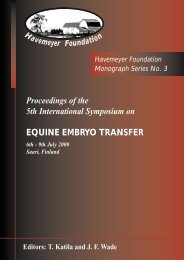Proceedings of a Workshop on - The Havemeyer Foundation
Proceedings of a Workshop on - The Havemeyer Foundation
Proceedings of a Workshop on - The Havemeyer Foundation
Create successful ePaper yourself
Turn your PDF publications into a flip-book with our unique Google optimized e-Paper software.
<strong>Havemeyer</strong> Foundati<strong>on</strong> M<strong>on</strong>ograph Series No. 11<br />
NON-RECURRENT LARYNGEAL NEUROPATHY (RLN)<br />
CAUSES OF EQUINE LARYNGEAL PARALYSIS<br />
B. McGorum and P. M. Dix<strong>on</strong><br />
Department <str<strong>on</strong>g>of</str<strong>on</strong>g> Veterinary Clinical Studies, Easter Bush Veterinary Centre, University <str<strong>on</strong>g>of</str<strong>on</strong>g> Edinburgh,<br />
Roslin, Midlothian EH25 9RG, UK<br />
N<strong>on</strong>-recurrent laryngeal neuropathy (n<strong>on</strong>-RLN)<br />
accounts for the small proporti<strong>on</strong> (6% Goulden<br />
and Anders<strong>on</strong> 1981; 11% Dix<strong>on</strong> et al. 2001) <str<strong>on</strong>g>of</str<strong>on</strong>g><br />
horses with laryngeal paralysis in which a<br />
probable cause can be identified. C<strong>on</strong>versely, RLN<br />
cases have no such detectable underlying cause.<br />
N<strong>on</strong>-RLN laryngeal paralysis may be a sequel<br />
to localised injury to the vagus or recurrent<br />
laryngeal nerves at any site al<strong>on</strong>g their circuitous<br />
courses. Such injury may occur in disorders <str<strong>on</strong>g>of</str<strong>on</strong>g> the<br />
guttural pouch (mycosis, rupture <str<strong>on</strong>g>of</str<strong>on</strong>g> the rectus<br />
capitis ventralis muscles, temporohyoid fracture,<br />
trauma), pharynx (trauma, abscessati<strong>on</strong>,<br />
neoplasia), neck (perivascular/perineural irritant<br />
injecti<strong>on</strong> reacti<strong>on</strong>s, trauma, iatrogenic nerve<br />
damage during oesophageal and thyroid surgery)<br />
or mediastinum (neoplasia, abscessati<strong>on</strong>). N<strong>on</strong>-<br />
RLN paralysis may also be a manifestati<strong>on</strong> <str<strong>on</strong>g>of</str<strong>on</strong>g> a<br />
generalised disorder, eg a polyneuropathy or<br />
myopathy. Bilateral laryngeal paralysis, which is<br />
c<strong>on</strong>siderably less comm<strong>on</strong> (2–6%) than unilateral<br />
paralysis, almost invariably results from<br />
generalised neuromuscular disorders.<br />
Liver disease is a comm<strong>on</strong> cause <str<strong>on</strong>g>of</str<strong>on</strong>g> bilateral<br />
laryngeal paralysis (Mayhew 1989; Pears<strong>on</strong> 1991;<br />
McGorum et al. 1999). McGorum et al. (1999)<br />
recorded bilateral laryngeal paralysis in 7 <str<strong>on</strong>g>of</str<strong>on</strong>g> 50<br />
horses with primary hepatic disease, all <str<strong>on</strong>g>of</str<strong>on</strong>g> which<br />
had hepatic encephalopathy and hyperamm<strong>on</strong>aemia.<br />
All cases presented with loud<br />
inspiratory stridor and many were referred for<br />
investigati<strong>on</strong> <str<strong>on</strong>g>of</str<strong>on</strong>g> suspected primary upper<br />
respiratory tract obstructi<strong>on</strong>. In all cases,<br />
endoscopy revealed total bilateral paralysis, with<br />
both arytenoids passively adducted to the midline<br />
during inspirati<strong>on</strong>. P<strong>on</strong>ies were affected more<br />
<str<strong>on</strong>g>of</str<strong>on</strong>g>ten than horses, but this probably reflects an<br />
increased frequency <str<strong>on</strong>g>of</str<strong>on</strong>g> liver failure in p<strong>on</strong>ies<br />
rather than increased susceptibility. <strong>The</strong> laryngeal<br />
paralysis was <str<strong>on</strong>g>of</str<strong>on</strong>g>ten temporary, worsening during<br />
exacerbati<strong>on</strong>s <str<strong>on</strong>g>of</str<strong>on</strong>g> encephalopathy and resolving<br />
with restorati<strong>on</strong> <str<strong>on</strong>g>of</str<strong>on</strong>g> hepatic functi<strong>on</strong>. No gross or<br />
histopathological abnormalities were identified in<br />
the laryngeal muscles, the recurrent laryngeal<br />
nerve or other peripheral nerves <str<strong>on</strong>g>of</str<strong>on</strong>g> affected horses.<br />
<strong>The</strong> pathogenesis <str<strong>on</strong>g>of</str<strong>on</strong>g> this complicati<strong>on</strong> remains<br />
unclear. Most reported cases are in horses with<br />
liver failure and hepatic encephalopathy, but it is<br />
unknown whether it occurs with compensated<br />
liver disease. Similarly, while it is reported in<br />
horses with pyrrolizidine alkaloid induced liver<br />
disease (Pears<strong>on</strong> 1991; McGorum et al. 1999), the<br />
role <str<strong>on</strong>g>of</str<strong>on</strong>g> this substance, which may be neurotoxic<br />
(Cooper and Huxtable 1999), is unclear. As the<br />
laryngeal paralysis may be temporary, and no<br />
histo-pathological lesi<strong>on</strong>s have been identified, it<br />
may reflect neuromuscular dysfuncti<strong>on</strong> rather than<br />
pathology. Such dysfuncti<strong>on</strong> could occur by<br />
mechanisms akin to those that cause hepatic<br />
encephalopathy. Alternatively, it may represent a<br />
form <str<strong>on</strong>g>of</str<strong>on</strong>g> peripheral neuropathy, a comm<strong>on</strong> sequel<br />
to human hepatic disease. <strong>The</strong> pathogenesis <str<strong>on</strong>g>of</str<strong>on</strong>g><br />
peripheral neuropathy in human liver disease<br />
patients is unknown, but may involve metabolic<br />
inhibiti<strong>on</strong> <str<strong>on</strong>g>of</str<strong>on</strong>g> ax<strong>on</strong>al membrane functi<strong>on</strong>,<br />
metabolic damage to Schwann cells and/or<br />
disordered insulin metabolism akin to diabetic<br />
neuropathy.<br />
Interestingly, all 3 p<strong>on</strong>ies with liver disease<br />
induced bilateral laryngeal paralysis that had postmortem<br />
examinati<strong>on</strong>s, also had pituitary<br />
adenomas, but no overt clinical hyperadrenocorticism<br />
(McGorum et al. 1999). While pituitary<br />
adenomas are relatively comm<strong>on</strong> in older p<strong>on</strong>ies,<br />
and may not relate to the laryngeal dysfuncti<strong>on</strong>,<br />
increased producti<strong>on</strong> <str<strong>on</strong>g>of</str<strong>on</strong>g> pituitary derived peptides<br />
may c<strong>on</strong>tribute to the pathogenesis <str<strong>on</strong>g>of</str<strong>on</strong>g> this<br />
complicati<strong>on</strong>. However, Pears<strong>on</strong> (1991) made no<br />
55








